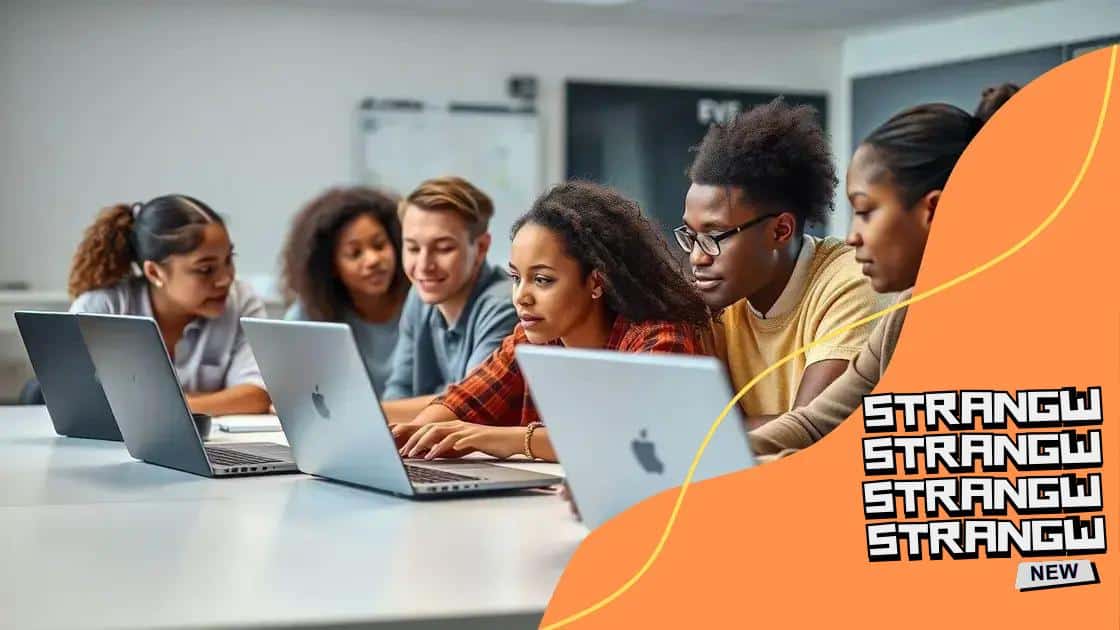The impact of virtual classrooms on student collaboration

The impact of virtual classrooms on student collaboration enhances communication and teamwork skills by utilizing technology to connect learners in diverse and flexible environments.
The impact of virtual classrooms on student collaboration is shaping the future of education. Many students now interact remotely, raising questions about the effectiveness of teamwork. How do these digital spaces change the dynamics of learning?
Understanding virtual classrooms
Understanding virtual classrooms requires exploring how learning environments have changed. With technology at our fingertips, classrooms are no longer confined to four walls. Students now engage in a new format that offers flexibility and accessibility.
In these virtual settings, learners can connect from anywhere in the world. This allows for a diverse range of interactions and a blend of cultural perspectives. Moreover, the ability to collaborate online teaches skills that are essential in today’s workforce.
Key Features of Virtual Classrooms
Virtual classrooms utilize various tools to enhance the learning experience. Some features include:
- Real-time communication: Video chat and messaging tools facilitate immediate interaction among students and teachers.
- Interactive resources: Shared documents and online whiteboards enable collaborative projects and brainstorming.
- Flexible scheduling: Students can attend classes at their convenience, allowing for better time management.
For many, the challenge lies in navigating these platforms. Online learning requires comfort with technology and self-discipline to stay engaged. As students adapt, they often discover innovative ways to work together remotely.
Benefits of Virtual Classrooms
The transition to virtual classrooms presents numerous advantages. Students can cultivate digital literacy, an essential skill in the modern job market. They also learn to communicate effectively with peers from different backgrounds, promoting inclusivity and teamwork.
In addition, virtual classrooms can provide personalized learning experiences. Educators can tailor lessons to meet individual needs, ensuring that each student progresses at their own pace. This adaptability improves overall comprehension and retention.
Understanding virtual classrooms goes beyond technology; it’s about building connections and developing skills that last a lifetime. Embracing these changes can lead to enriching educational experiences for everyone involved.
Benefits of collaboration in online learning
Benefits of collaboration in online learning extend beyond academic achievements. This collaborative environment fosters a sense of community among students, even when they are miles apart. Engaging with peers pushes students to share ideas and strategies, enhancing their understanding of the subject matter.
In virtual settings, students often rely on each other for support. This reliance helps to break down barriers and encourages them to ask questions openly. Collaboration becomes a vital element in building confidence and communication skills.
Key Advantages of Online Collaboration
Several key benefits illustrate why collaboration is crucial:
- Diverse perspectives: Working with classmates from various backgrounds introduces different viewpoints, enriching the learning experience.
- Enhanced problem-solving: Group discussions lead to creative solutions as students brainstorm together.
- Accountability: Knowing that others are counting on them encourages students to stay engaged and meet deadlines.
Collaboration also promotes the development of critical thinking skills. When students discuss ideas or tackle challenges together, they learn to evaluate different argument styles. This process sharpens their reasoning and analytical abilities.
Improving Social Connections
The social aspects of collaboration in online learning cannot be overlooked. Virtual environments provide opportunities for students to bond over shared experiences, even when they are not physically together. Engaging with classmates through group projects or discussion forums fosters a sense of belonging.
Furthermore, these relationships often extend beyond academic work. Students can form friendships that support them in their educational journey. As they work together, they build trust and camaraderie, essential components of a positive learning atmosphere.
In conclusion, the benefits of collaboration in online learning are multifaceted. From fostering critical thinking to creating lasting friendships, collaboration enriches the online educational experience and prepares students for future teamwork scenarios.
Tools that facilitate student collaboration

Tools that facilitate student collaboration play a crucial role in creating effective virtual learning environments. These tools bridge the gap between students, allowing them to work together seamlessly, even when apart.
Many platforms offer unique features that cater to different collaborative needs. For instance, video conferencing tools enable face-to-face interaction, fostering a sense of community among learners. Meanwhile, file-sharing services allow students to access and edit shared documents conveniently.
Essential Collaboration Tools
Here are some of the most popular tools that enhance student collaboration:
- Google Workspace: Includes Google Docs, Sheets, and Slides for real-time collaboration on documents and presentations.
- Zoom: A widely used video conferencing tool that allows virtual meetings and classroom sessions.
- Trello: A project management tool that helps teams organize tasks and collaborate on projects.
- Slack: A messaging platform designed for team communication and collaboration, featuring channels for different topics.
Using these tools, students can easily share ideas and provide feedback. This not only enhances their understanding but also encourages active participation. When students communicate through platforms like Zoom or Slack, they develop essential skills that will benefit them in their future careers.
Benefits of Using Collaborative Tools
The integration of these tools in virtual learning environments brings about various advantages. Students gain access to multiple resources that can enhance their projects. Additionally, collaborative technology promotes inclusivity by ensuring all voices are heard, allowing quieter students to express their thoughts.
The ease of sharing information leads to improved teamwork. As students harness these tools, they learn to manage time better and coordinate effectively with their peers. The skills cultivated during this collaboration are invaluable, preparing them for real-world challenges.
In summary, tools that facilitate student collaboration are essential for creating a productive online learning atmosphere. By leveraging technology, learners can thrive in virtual classrooms, enhancing their educational experience and fostering lifelong collaboration skills.
Challenges faced in virtual collaboration
Challenges faced in virtual collaboration can impact the learning experience for students. While online tools enhance communication, they also introduce unique difficulties that must be addressed to ensure effective teamwork.
One major challenge is the lack of in-person interaction. Without face-to-face communication, students may struggle to build relationships and trust with their peers. This can lead to feelings of isolation, which can hinder participation and motivation.
Common Issues in Virtual Collaboration
Several common issues arise during virtual collaboration:
- Technical difficulties: Students may encounter problems with internet connectivity or software compatibility, causing disruptions during collaboration.
- Miscommunication: Without physical cues, students might misinterpret messages, leading to confusion and misunderstandings.
- Time zone differences: For students in different regions, coordinating schedules can be challenging, making it hard to find convenient meeting times.
- Lack of engagement: In a virtual setting, some students might become disengaged or distracted, affecting group dynamics and productivity.
Addressing these issues is crucial for successful online teamwork. In many cases, the absence of non-verbal signals can lead to misunderstandings. Students may find it hard to express their ideas or emotions clearly.
Navigating Collaboration Challenges
To improve virtual collaboration experiences, students should establish clear communication norms. Utilizing tools like video conferencing can help mitigate feelings of isolation. Regular check-ins can foster better connections among team members. Additionally, setting specific goals can help keep everyone focused and accountable.
When students encounter technical difficulties, it’s important to find solutions together. This collaborative spirit not only resolves issues but also strengthens their problem-solving skills.
Exploring these challenges in virtual collaboration highlights the importance of adaptability. By working together to overcome obstacles, students can improve their teamwork skills and learn to effectively navigate a digital landscape.
Best practices for effective teamwork in virtual settings
Best practices for effective teamwork in virtual settings are essential for ensuring that students can collaborate efficiently. With the right strategies in place, virtual teams can thrive despite the challenges posed by distance.
One essential practice is to establish clear communication guidelines. Teams should agree on how and when to communicate, whether through email, messaging apps, or video calls. This clarity helps prevent misunderstandings and keeps everyone on the same page.
Key Strategies for Successful Virtual Teamwork
Here are some best practices to enhance collaboration:
- Set specific roles: Assign roles to each team member based on their strengths and skills. This ensures that everyone knows their responsibilities.
- Regular check-ins: Schedule frequent meetings to discuss progress and address any issues. This keeps the team accountable and engaged.
- Utilize collaborative tools: Take advantage of online tools like Trello and Google Workspace to manage tasks and share documents effectively.
- Encourage feedback: Create a culture where team members feel comfortable giving and receiving feedback. This helps improve teamwork and understanding.
Another vital practice is fostering a sense of community. Virtual teams can benefit greatly from team-building activities that create camaraderie. Simple activities like virtual coffee breaks or icebreaker games can help lighten the mood and build rapport.
Enhancing Engagement in Virtual Teams
Maintaining high engagement levels in virtual settings can be challenging. To tackle this, leaders should celebrate achievements, both big and small, to boost morale. Recognizing individual contributions fosters motivation and encourage participation.
Additionally, setting clear deadlines helps keep projects on track. When team members understand their timelines, they are more likely to stay focused and committed. This also allows for better time management and planning.
By incorporating these best practices for effective teamwork in virtual settings, students can cultivate a productive and supportive online environment. These strategies not only enhance collaboration but also equip individuals with the skills they need for future success.
In summary, the transition to virtual classrooms has significantly impacted student collaboration. By embracing the challenges and utilizing the right tools, students can thrive in an online environment. Effective virtual teamwork not only enhances learning experiences but also prepares students for future success. By following best practices, such as setting clear communication guidelines and fostering a sense of community, students can enjoy the benefits of collaboration while overcoming obstacles. Ultimately, understanding and adapting to these changes will help create a more connected and engaged learning experience for everyone involved.
FAQ – Frequently Asked Questions about Virtual Classrooms and Student Collaboration
What are the main benefits of virtual classrooms for collaboration?
Virtual classrooms enhance collaboration by allowing students to connect from anywhere, fostering diverse viewpoints and improving communication skills.
What tools can improve student collaboration in online settings?
Tools like Google Workspace, Zoom, and Trello facilitate real-time communication, document sharing, and project management, making collaboration easier.
How can students overcome challenges faced in virtual collaboration?
Students can overcome challenges by establishing clear communication norms, scheduling regular check-ins, and using collaborative tools effectively.
What best practices should students follow for effective teamwork online?
Students should set specific roles, maintain regular communication, utilize collaborative tools, and engage in team-building activities to improve teamwork.





